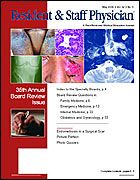Publication
Article
Resident & Staff Physician®
Anisakis spp. in humans
As exotic international locales become more accessible and American palates acquire a taste for more unusual fare, physicians may find themselves treating patients infected with organisms that are rarely seen in the United States, such as Anisakis spp.
Intestinal parasites cause significant morbidity and mortality worldwide, and they are particularly prevalent in underdeveloped countries. Those routinely encountered in the United States include Enterobius vermicularis, Ancylostoma duodenale, Necator americanus, Giardia lamblia, and Entamoeba histolytica.1 But as exotic international locales become more accessible and American palates acquire a taste for more unusual fare, physicians may find themselves treating patients infected with organisms that are acquired abroad or rarely seen in the United States, such as Anisakis spp.
Anisakid nematodes (family Anisakidae) are classified into the superfamily Ascaridoidea, which contains the well-known human pathogen Ascaris lumbricoides. All anisakids are transmitted in water and use aquatic invertebrates and fish as intermediate or paratenic (transport) hosts. These parasites mature in fish, birds, and marine mammals. Species of medical importance include the whaleworms (Anisakis spp.) and the sealworms (Pseudoterranova spp.), both of which comprise a complex of morphologically similar species that can be differentiated by electrophoretic or molecular methods.
Pseudoterranova spp. typically use seals and sea lions as their definitive hosts. Because the larvae of these parasites are large and readily visible in the flesh of many commercial fish and are typically not pathogenic in humans, sealworm infections are rare. Larvae of Pseudoterranova spp. have been found in more than 40 species of fish in the North Atlantic and tend to occur primarily in benthic or demersal fish.
In contrast to Pseudoterranova spp., the larvae of Anisakis spp. are generally encapsulated on the viscera of fish, but they can occur in the flesh, where they are difficult to see because of their small size and translucency. According to the Centers for Disease Control and Prevention, fewer than 10 cases of Anisakis spp. infection are diagnosed annually in the United States, a surprisingly low number when you consider the prevalence of this parasite in numerous fish species that inhabit the Atlantic and Pacific oceans. Whaleworm larvae typically mature in both toothed and baleen cetaceans. To date, nine species of Anisakis have been identified, and these may vary in their final cetacean hosts and geographical distribution. The larvae of Anisakis spp. have been found in more than 50 species in North Atlantic and infect both pelagic and demersal fish.
Once anisakid larvae are ingested, they immediately begin to penetrate the gastric and intestinal mucosa, causing the first symptoms of anisakiasis, often within 24 hours. According to the Food and Drug Administration, Anisakis spp. infection is frequently diagnosed when the affected individual feels a tingling or tickling sensation in the throat and coughs up or manually extracts a nematode.2 In more severe cases, patients may experience nausea and abdominal pain that is reminiscent of acute appendicitis. These symptoms can manifest from 1 hour to 2 weeks after infection. The March 2008 issue of Surgical Rounds includes the case of a female patient who developed abdominal pain, nausea, and emesis shortly after eating a sushi dinner. Although her symptoms resolved the following morning, they recurred 1 week later and persisted for 5 days, which prompted the patient to seek emergency care. A computed tomography scan of the patient's abdomen revealed a proximal small bowel obstruction.
To prevent Anisakis spp. infection, fish must be thoroughly cooked or frozen to ensure that any larvae are killed. Anisakis spp. infections are more prevalent in Japan, Spain, and Scandinavia, where raw or undercooked seafood dishes frequently appear on the menu, but Americans are increasing their consumption of sushi and other raw or undercooked seafood. As a result, US physicians may encounter a growing number of patients who have parasitic infections or suffer from their associated complications, such as Anisakis spp.-related bowel obstruction.
For more information on the life-cycle of Anisakis spp. and the diagnosis and treatment of anisakiasis, see "Is it safe to eat sushi? Bowel obstruction related to anisakiasis," published by Dr. Roland and colleagues in the March 2008 issue of Surgical Rounds.
*David J. Marcogliese, PhD, is a research scientist for the Aquatic Ecosystem Protection Research Division of the Science and Technology Branch of Environment Canada in Montreal.
REFERENCES
- Common Intestinal Parasites. Available at: www.aafp.org/afp/20040301/1161.html.
- Anisakis simplex and related worms. Available at: www.cfsan.fda.gov/~mow/chap25.html.
